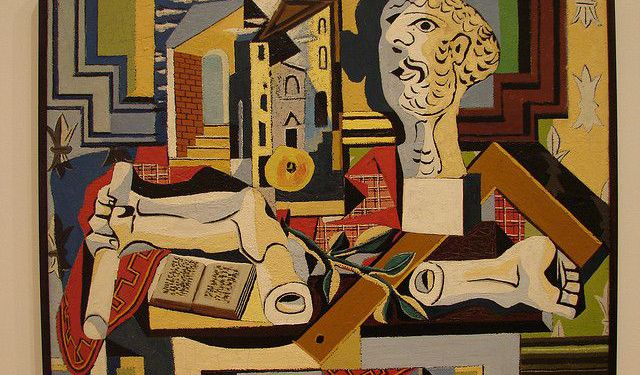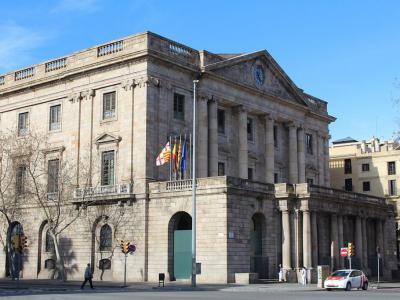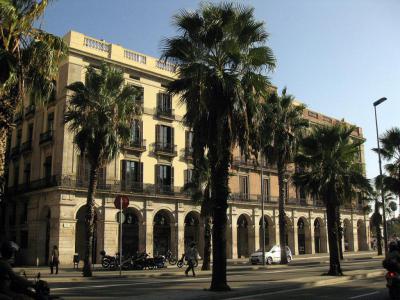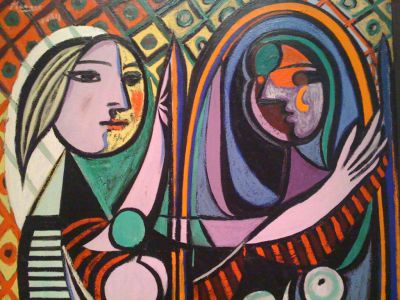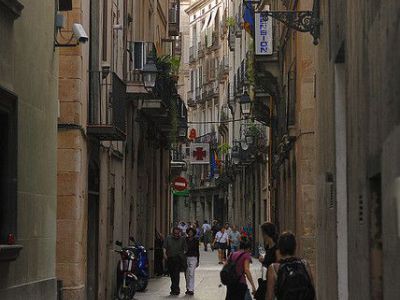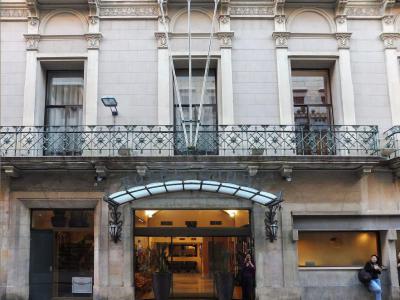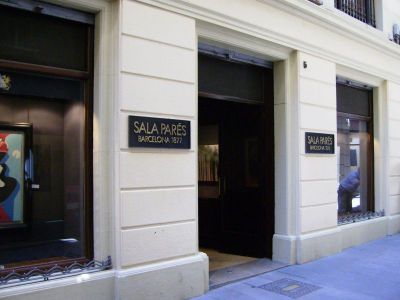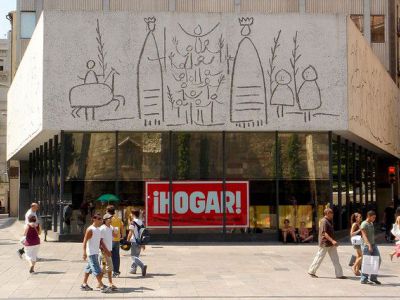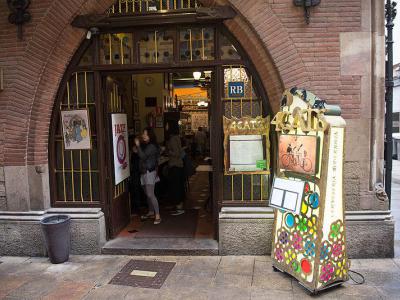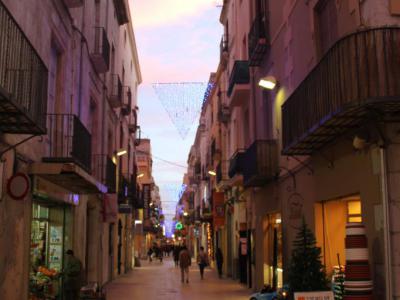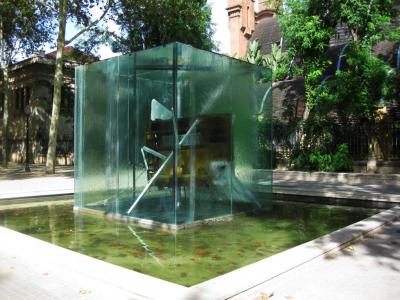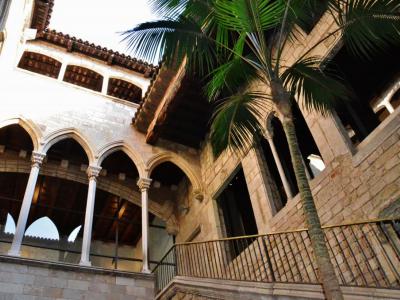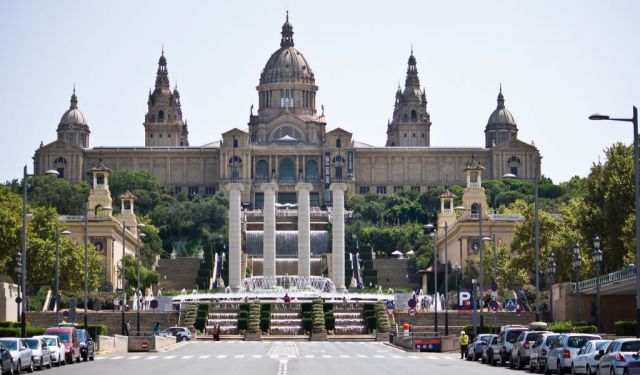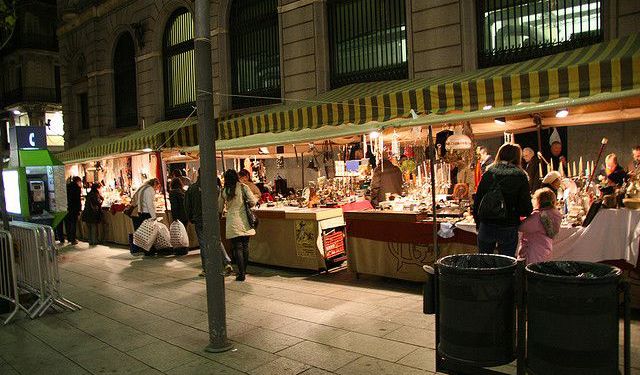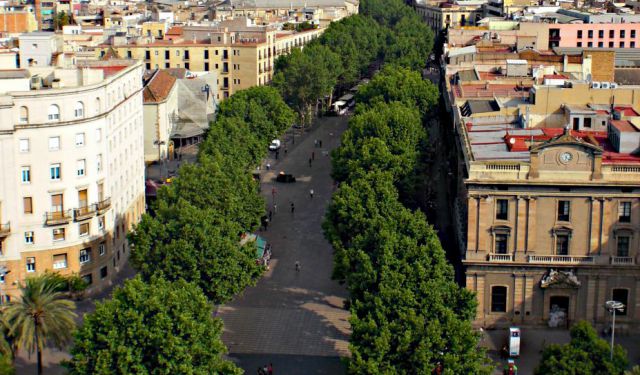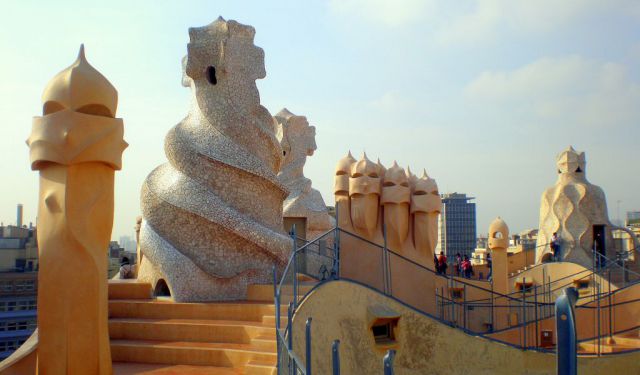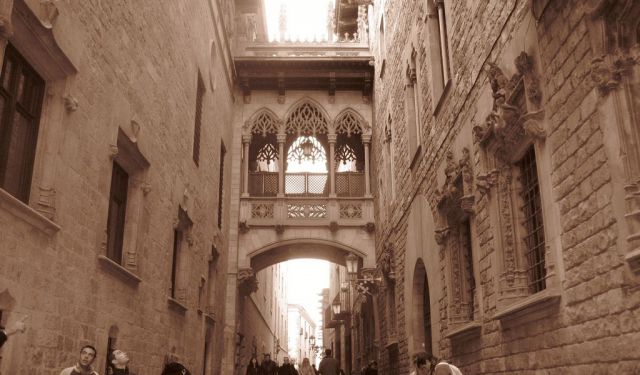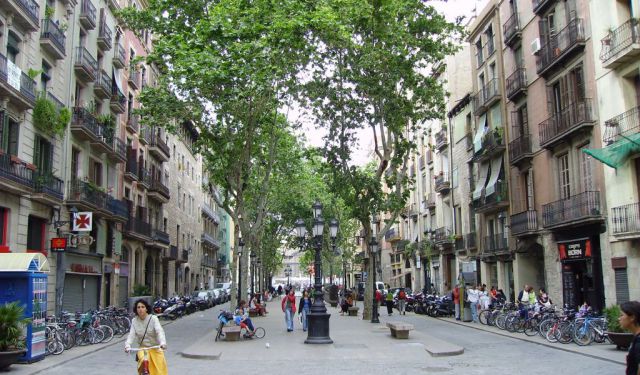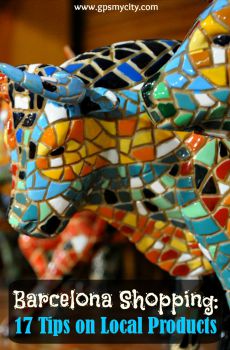Picasso's Barcelona Walking Tour (Self Guided), Barcelona
Pablo Picasso – the great Spanish painter and sculptor – developed his style in Barcelona where he spent the formative years of his life, from the ages of 14 to 23. It is said that when the master spoke nostalgically of home, he actually meant the Catalonian capital, despite having been born in Malaga.
This self-guided walk will take you to the Picasso Museum, the bar-restaurant and the art gallery where his works were first displayed to the public, as well as other bohemian sites associated with the artist’s life – including some of the favorite haunts of the vibrant “modernista” period.
As soon as his family moved to Barcelona, the young genius enrolled in art school; thus, it only makes sense that your tour route should start off at the very building (Llotja de Barcelona) where he drew his early self-portraits, followed by the one he climbed on to initially survey the urban landscape.
As a youth, Picasso eventually fell in with a crowd that mixed wine, women, and art. Step inside the café 4 Gats or walk along Carrer Avinyó to soak in the ambience that inspired his famous painting, ‘Les Demoiselles d'Avignon’.
Passing alongside several buildings that housed his studios, you will see the street that bears his name, before finally reaching the dedicated museum at Carrer de Montcada, where the master was happy to add to the collection throughout his life. Scattered through several connected Gothic palaces, the artworks include two early major paintings: The First Society (1896), and Science and Charity (1897).
Take our self-guided walking tour to discover Picasso’s connections with Barcelona and the unique sights that inspired many of his works.
This self-guided walk will take you to the Picasso Museum, the bar-restaurant and the art gallery where his works were first displayed to the public, as well as other bohemian sites associated with the artist’s life – including some of the favorite haunts of the vibrant “modernista” period.
As soon as his family moved to Barcelona, the young genius enrolled in art school; thus, it only makes sense that your tour route should start off at the very building (Llotja de Barcelona) where he drew his early self-portraits, followed by the one he climbed on to initially survey the urban landscape.
As a youth, Picasso eventually fell in with a crowd that mixed wine, women, and art. Step inside the café 4 Gats or walk along Carrer Avinyó to soak in the ambience that inspired his famous painting, ‘Les Demoiselles d'Avignon’.
Passing alongside several buildings that housed his studios, you will see the street that bears his name, before finally reaching the dedicated museum at Carrer de Montcada, where the master was happy to add to the collection throughout his life. Scattered through several connected Gothic palaces, the artworks include two early major paintings: The First Society (1896), and Science and Charity (1897).
Take our self-guided walking tour to discover Picasso’s connections with Barcelona and the unique sights that inspired many of his works.
How it works: Download the app "GPSmyCity: Walks in 1K+ Cities" from Apple App Store or Google Play Store to your mobile phone or tablet. The app turns your mobile device into a personal tour guide and its built-in GPS navigation functions guide you from one tour stop to next. The app works offline, so no data plan is needed when traveling abroad.
Picasso's Barcelona Walking Tour Map
Guide Name: Picasso's Barcelona Walking Tour
Guide Location: Spain » Barcelona (See other walking tours in Barcelona)
Guide Type: Self-guided Walking Tour (Sightseeing)
# of Attractions: 11
Tour Duration: 2 Hour(s)
Travel Distance: 4.2 Km or 2.6 Miles
Author: DanaOffice
Sight(s) Featured in This Guide:
Guide Location: Spain » Barcelona (See other walking tours in Barcelona)
Guide Type: Self-guided Walking Tour (Sightseeing)
# of Attractions: 11
Tour Duration: 2 Hour(s)
Travel Distance: 4.2 Km or 2.6 Miles
Author: DanaOffice
Sight(s) Featured in This Guide:
- Llotja de Mar
- Passeig d'Isabel II, 4 (Isabella II Boulevard)
- Carrer de la Plata, 4 (La Plata Street)
- Carrer d'Avinyo, 44 (Avinyó Street)
- Carrer Nou de la Rambla, 10 (New Rambla Street)
- Sala Pares
- Col·legi d'Arquitectes de Catalunya (College of Catalan Architects)
- 4 Gats (Els Quatre Gats)
- Carrer del Comerc, 28 (Commerce Street)
- Homenatge a Picasso (Tribute to Picasso)
- Museu Picasso (Picasso Museum)
1) Llotja de Mar
Constructed between 1380 and 1392, the Llotja de Mar stands as Barcelona's eminent example of civil architecture and served as the hub of the city's maritime trade. Though the neoclassical fashion of the late 18th century unfortunately covered its facades, the interior remains a testament to its original glory. The magnificent Gothic Hall, known as Saló Gòtic, witnessed countless balls and celebrations throughout the 19th century. It was utilized as the Barcelona stock exchange until 1975 and later as the grain exchange until 2001. Thanks to a brilliant restoration, the hall now shines with its graceful arches, columns, and floors adorned with light Carrara and dark Genovese marble. While access to the building is typically restricted, it currently houses the Barcelona Chamber of Commerce.
From 1849 to 1960, the School of Fine Arts ("Escola de Belles Arts") occupied the southwestern corner of the Llotja. Esteemed artists from Barcelona, including Gaudí, Miró, and Picasso, received their education within its walls. The Llotja still serves as the seat of the Royal Catalan Academy of Fine Arts of Saint George, housing a semi-secret art collection that includes medieval paintings by unknown artists and modern works by academy members (notably, there is a splendid 17th-century depiction of Saint Jerome by Joan Ribalta).
Tip:
To access the Gothic Hall ("Saló Gòtic"), descend the stairs from the museum to the 2nd floor, then follow the marble staircase down and turn right. Guided visits to the museum collection are available for groups of 10 to 25 individuals, and admission is free.
***PICASSO'S BARCELONA***
Aged 13, Pablo Picasso joined the School of Fine Arts ("Escola de Llotja") in 1895. During that period, the school – where his father, Don José, was a teacher – occupied the top floor of the building. Despite being younger than his fellow classmates, Don José successfully arranged for Pablo to attend advanced classes by presenting a pair of charcoal drawings of a live model to a panel of art teachers. While most students typically spent four weeks working on the two important sketches, Pablo astonishingly completed them in just one week. These drawings, which showcase his talent, are still preserved in the school's archival collection.
[Royal Academy Museum]:
Mon-Fri: 10am–2pm
From 1849 to 1960, the School of Fine Arts ("Escola de Belles Arts") occupied the southwestern corner of the Llotja. Esteemed artists from Barcelona, including Gaudí, Miró, and Picasso, received their education within its walls. The Llotja still serves as the seat of the Royal Catalan Academy of Fine Arts of Saint George, housing a semi-secret art collection that includes medieval paintings by unknown artists and modern works by academy members (notably, there is a splendid 17th-century depiction of Saint Jerome by Joan Ribalta).
Tip:
To access the Gothic Hall ("Saló Gòtic"), descend the stairs from the museum to the 2nd floor, then follow the marble staircase down and turn right. Guided visits to the museum collection are available for groups of 10 to 25 individuals, and admission is free.
***PICASSO'S BARCELONA***
Aged 13, Pablo Picasso joined the School of Fine Arts ("Escola de Llotja") in 1895. During that period, the school – where his father, Don José, was a teacher – occupied the top floor of the building. Despite being younger than his fellow classmates, Don José successfully arranged for Pablo to attend advanced classes by presenting a pair of charcoal drawings of a live model to a panel of art teachers. While most students typically spent four weeks working on the two important sketches, Pablo astonishingly completed them in just one week. These drawings, which showcase his talent, are still preserved in the school's archival collection.
[Royal Academy Museum]:
Mon-Fri: 10am–2pm
2) Passeig d'Isabel II, 4 (Isabella II Boulevard)
After their journey by boat from La Coruña to Barcelona in 1895, the Ruiz y Picasso family first settled on Passeig d'Isabel II, conveniently located near the port and directly across from the Llotja building, where Pablo's father, José Ruiz y Blasco, was set to teach figure drawing and young Pablo, on the verge of turning 14, would become a student.
Barcelona was alive with ideas, political movements, and artistic endeavors, attracting the attention of many Catalans who were captivated by the emerging intellectual movement known as "modernismo". In between exploring the vibrant city, Pablo frequently ascended to the rooftop of the building, surveying the urban landscape and drawing inspiration for his paintings. Notably, the "Rooftop of Les Cases d'En Xifré" (his first artwork in Barcelona) and other significant pieces that would eventually grace the Museu Picasso collection were born from these moments of contemplation.
Tip:
Within the building's premises, you'll find the Mint Bar, a trendy establishment that boasts an extensive selection of cocktails and a stylish dance hall located downstairs.
Barcelona was alive with ideas, political movements, and artistic endeavors, attracting the attention of many Catalans who were captivated by the emerging intellectual movement known as "modernismo". In between exploring the vibrant city, Pablo frequently ascended to the rooftop of the building, surveying the urban landscape and drawing inspiration for his paintings. Notably, the "Rooftop of Les Cases d'En Xifré" (his first artwork in Barcelona) and other significant pieces that would eventually grace the Museu Picasso collection were born from these moments of contemplation.
Tip:
Within the building's premises, you'll find the Mint Bar, a trendy establishment that boasts an extensive selection of cocktails and a stylish dance hall located downstairs.
3) Carrer de la Plata, 4 (La Plata Street)
Following the enthusiastic reception of his artwork "The First Communion" at the Third Exhibition of Arts and Artistic Industries in Barcelona in 1896, Picasso's father decided to rent a workshop for him. Located at No. 4 of La Plata Street in the Ribera neighborhood, it was conveniently close to their family home on La Mercè Street.
It was in this humble workshop where a young Picasso, aged 15 or 16, created many of his early masterpieces, including the renowned "Science and Charity". The painting depicted his sister Lola, portrayed as sick in bed, with his father posing as the attending doctor. This highly realistic artwork even won a prize at an exhibition in Madrid, triumphing over some of Spain's most accomplished artists.
Presently, the location of Picasso's former workshop has transformed into a luxurious boutique hotel known as Serras Hotel. Paying homage to the artist, the hotel features a Picasso Suite, allowing guests to immerse themselves in an atmosphere that celebrates the legacy of the iconic painter.
It was in this humble workshop where a young Picasso, aged 15 or 16, created many of his early masterpieces, including the renowned "Science and Charity". The painting depicted his sister Lola, portrayed as sick in bed, with his father posing as the attending doctor. This highly realistic artwork even won a prize at an exhibition in Madrid, triumphing over some of Spain's most accomplished artists.
Presently, the location of Picasso's former workshop has transformed into a luxurious boutique hotel known as Serras Hotel. Paying homage to the artist, the hotel features a Picasso Suite, allowing guests to immerse themselves in an atmosphere that celebrates the legacy of the iconic painter.
4) Carrer d'Avinyo, 44 (Avinyó Street)
An old street in the heart of Barcelona, Carrer d'Avinyo holds historical significance as the home of the brothel at number 44, which was said to have inspired Picasso's groundbreaking painting "Les Demoiselles d'Avignon" ("The Young Ladies of Avignon"), a masterpiece that marked the painter's transition toward the cubist movement. Revolutionizing the art world through its analysis, deconstruction, and reassembly of objects in an abstracted manner, cubism profoundly transformed Picasso's perception of art. Despite its initial lack of acceptance, the cubist style would ultimately emerge as one of the pivotal art movements of the 20th century.
Today, you can still locate the site where the former brothel stood on Carrer Avinyo. While the area is now renowned for its abundance of restaurants and cafes, the typically narrow medieval street retains much of its medieval charm, evoking the atmosphere that was prevalent during Picasso's time.
Today, you can still locate the site where the former brothel stood on Carrer Avinyo. While the area is now renowned for its abundance of restaurants and cafes, the typically narrow medieval street retains much of its medieval charm, evoking the atmosphere that was prevalent during Picasso's time.
5) Carrer Nou de la Rambla, 10 (New Rambla Street)
From 1901 to 1904, Pablo Picasso experienced a period of constant movement between Barcelona and Paris. During this time, he immersed himself in painting using predominantly shades of blue, abandoning his previous lighter and more colorful style, which had been heavily influenced by the impressionists. His paintings were not selling well, however, leading him to reside in cheap hotel rooms and rundown apartments.
The studio in the Raval neighborhood, which he rented in 1902 alongside painter Josep Rocarol and sculptor Angel Fernandez de Soto, was situated on the top of the building. Here, Picasso painted roof terraces and drew sketches of singers at the variety hall just next door. Some of the other recurring subjects in his depression-driven "Blue Period" were poverty, addiction, and the female nude.
The studio in the Raval neighborhood, which he rented in 1902 alongside painter Josep Rocarol and sculptor Angel Fernandez de Soto, was situated on the top of the building. Here, Picasso painted roof terraces and drew sketches of singers at the variety hall just next door. Some of the other recurring subjects in his depression-driven "Blue Period" were poverty, addiction, and the female nude.
6) Sala Pares
Located on Carrer Petritxol in the Gothic Quarter, an area renowned for its stunning architecture ideal for exploration and photography, Sala Parés holds the distinction of being the oldest art gallery in Barcelona. Originally established in 1840 as an art-supplies shop by Joan Parés, it gradually transformed into a gallery and officially assumed that role in 1877. Since then, Sala Parés has exhibited the works of every notable Barcelona artist, having gained fame as the venue where Picasso held his first commercial exhibition in 1901, at the youthful age of 20. Today, Sala Parés proudly showcases the works of esteemed Catalan artists such as Perico Pastor and Carlos Morago.
With its extensive and illustrious history, the gallery features three well-lit public display areas and a separate salon for private owners, ensuring easy accessibility and navigation for visitors.
With its extensive and illustrious history, the gallery features three well-lit public display areas and a separate salon for private owners, ensuring easy accessibility and navigation for visitors.
7) Col·legi d'Arquitectes de Catalunya (College of Catalan Architects)
Opposite the Barcelona Cathedral, the College of Catalan Architects proudly showcases three scaled friezes by Pablo Picasso on its facade, making it a compelling destination in its own right. Originally created on paper, these friezes – Children, Giants, and Flag – were immortalized in stone by Norwegian sculptor Carl Nesjar in 1955. Notably, they are the only outdoor displays of Picasso's artwork. On the Carrer Capellans side, the frieze captures the Cors de Clavé, the groups from the hermitage of Sant Medir, as well as the "fauns" of Arrabassada and Les Planes.
Tip:
For an affordable dining option, visit the coffee shop on the second floor, which offers a reasonably priced weekday menu with a wide variety of first and second course options.
Tip:
For an affordable dining option, visit the coffee shop on the second floor, which offers a reasonably priced weekday menu with a wide variety of first and second course options.
8) 4 Gats (Els Quatre Gats)
Els 4 Gats (or, "The Four Cats"), one of Barcelona's most historic bar-restaurants, opened its doors in 1897, originally encompassing a restaurant, pub, cabaret, and even a hostel. During the era of Catalan modernism at the turn of the century, it held the same significance for artists as iconic Parisian cafes like La Rotonde did in the 1920s, serving as a hub for art theories, lively debates over wine, and showcasing the works of emerging artists like Pablo Picasso. In fact, in 1900, this locale hosted Picasso's first solo exhibition, a momentous occasion in his career. The exhibition showcased over 50 portraits of his friends and family and another 60 or so drawings and paintings, at last earning him some critical attention.
Reopened at the same site in 1989, El 4 Gats is nowadays more of a meeting place for tourists than for artists and intellectuals, but still worth a stop to have a quick drink or a meal in downtown Barcelona. The interior décor is straight out of the epoch and you may spot a waiter or two who look as if they belong to that bygone era, too! Treat yourself to a reasonably priced glass of wine, vermouth, or a "licor de hierbas" (pomace brandy) as you soak up the unique and historic ambiance of the bar.
The menu offers a well-cooked lobster paella and some rather sinful desserts such as the tantalizing "textures of chocolate" (a trio of different chocolate desserts in one) or the delicately smooth and not overly sweet "Crema Catalana" (Spain's version of crème brûlée).
Reopened at the same site in 1989, El 4 Gats is nowadays more of a meeting place for tourists than for artists and intellectuals, but still worth a stop to have a quick drink or a meal in downtown Barcelona. The interior décor is straight out of the epoch and you may spot a waiter or two who look as if they belong to that bygone era, too! Treat yourself to a reasonably priced glass of wine, vermouth, or a "licor de hierbas" (pomace brandy) as you soak up the unique and historic ambiance of the bar.
The menu offers a well-cooked lobster paella and some rather sinful desserts such as the tantalizing "textures of chocolate" (a trio of different chocolate desserts in one) or the delicately smooth and not overly sweet "Crema Catalana" (Spain's version of crème brûlée).
9) Carrer del Comerc, 28 (Commerce Street)
Picasso's final studio in Barcelona was graciously lent to him by Catalan sculptor Pau Gargallo, known for his involvement in the decoration of numerous astounding modernist projects throughout the city. The same building housed the studio of painter Isidre Nonell, who would influence Picasso's work not so much with regard to style, but rather with thematic and conceptual affinity. Picasso occupied this studio until his permanent departure to Paris in April 1904, marking the end of his time in Barcelona.
Tip:
Located at No. 36 of the same street, you'll discover the community center named Centre Cívic Convent de Sant Agustí, which plays a pivotal role in driving positive changes within the neighborhood and is housed within the renovated Convent de Sant Agustí. With its 13th-century cloister serving as a remarkable performance venue, the convent is complemented by a diverse cultural program that includes workshops, concerts, and a special emphasis on electronic and experimental music and art. Additionally, be sure not to overlook the outstanding convent café.
Tip:
Located at No. 36 of the same street, you'll discover the community center named Centre Cívic Convent de Sant Agustí, which plays a pivotal role in driving positive changes within the neighborhood and is housed within the renovated Convent de Sant Agustí. With its 13th-century cloister serving as a remarkable performance venue, the convent is complemented by a diverse cultural program that includes workshops, concerts, and a special emphasis on electronic and experimental music and art. Additionally, be sure not to overlook the outstanding convent café.
10) Homenatge a Picasso (Tribute to Picasso)
The street they named for Picasso – though not particularly fashionable or glamourous – is in the area the painter knew best, close to his family's apartments, the art school where his father taught drawing (and where he studied for a short while), the studios he had as an emerging painter, and the bars he frequented.
Here also, on the outskirts of Parc de la Ciutadella, stands the monument dedicated to Picasso. Commissioned by Barcelona's city council in 1981 and created by Catalan artist Antoni Tapies, the monument holds an air of mystery. It consists of a glass box submerged in a pool of water, showcasing an uncompromising assemblage of modernist furniture reminiscent of Picasso's era. Resisting meaning, or easy interpretation, the sculpture captivates as an exciting piece of public art, symbolizing the profound bond between the artist and the city.
Within the glass cube, white sheets bear Picasso's quotes in Catalan, notably including the following: "A painting is not intended to decorate a drawing room but is instead a weapon of attack and defense against the enemy."
Here also, on the outskirts of Parc de la Ciutadella, stands the monument dedicated to Picasso. Commissioned by Barcelona's city council in 1981 and created by Catalan artist Antoni Tapies, the monument holds an air of mystery. It consists of a glass box submerged in a pool of water, showcasing an uncompromising assemblage of modernist furniture reminiscent of Picasso's era. Resisting meaning, or easy interpretation, the sculpture captivates as an exciting piece of public art, symbolizing the profound bond between the artist and the city.
Within the glass cube, white sheets bear Picasso's quotes in Catalan, notably including the following: "A painting is not intended to decorate a drawing room but is instead a weapon of attack and defense against the enemy."
11) Museu Picasso (Picasso Museum)
For an unparalleled experience of early Picasso, the Picasso Museum in Barcelona is the ultimate destination. Established in 1961, this museum presents a remarkable collection of over 4,300 works by the renowned master, showcasing his formative years and highlighting the profound connection he shared with Barcelona, the city that greatly shaped his character and largely influenced his art.
Picasso harbored a deep desire to leave his artistic imprint on the fabric of Barcelona, and this wish was graciously fulfilled by his colleagues and friends, most notably Jaime Sabartés, who adorned the city with the magnificent works of one of history's greatest artists.
While the majority of the artworks exhibited at the museum represent Picasso's early endeavors, the overall collection looks quite impressive. Encompassing the period from 1917, it includes iconic series such as Las Meninas, highlighting the artist's extraordinary talent. In 2008, the museum also unveiled a significant display of Picasso's prints.
If you have a keen interest in Picasso's artistic journey and wish to witness his remarkable progression from a young prodigy to a mature artist, expressed through paintings, sculptures, ceramics, and various other mediums, a visit to this museum is an absolute must.
Tip:
And if you do visit, be sure to venture into the museum shop, as it offers fascinating and unique items not easily found elsewhere.
Picasso harbored a deep desire to leave his artistic imprint on the fabric of Barcelona, and this wish was graciously fulfilled by his colleagues and friends, most notably Jaime Sabartés, who adorned the city with the magnificent works of one of history's greatest artists.
While the majority of the artworks exhibited at the museum represent Picasso's early endeavors, the overall collection looks quite impressive. Encompassing the period from 1917, it includes iconic series such as Las Meninas, highlighting the artist's extraordinary talent. In 2008, the museum also unveiled a significant display of Picasso's prints.
If you have a keen interest in Picasso's artistic journey and wish to witness his remarkable progression from a young prodigy to a mature artist, expressed through paintings, sculptures, ceramics, and various other mediums, a visit to this museum is an absolute must.
Tip:
And if you do visit, be sure to venture into the museum shop, as it offers fascinating and unique items not easily found elsewhere.
Walking Tours in Barcelona, Spain
Create Your Own Walk in Barcelona
Creating your own self-guided walk in Barcelona is easy and fun. Choose the city attractions that you want to see and a walk route map will be created just for you. You can even set your hotel as the start point of the walk.
Montjuic Walking Tour
Montjuic is a hill in Barcelona which offers a variety of great attractions of historic, cultural, and architectural value. Here, you can watch a spectacular water show at the Magic Fountain of Montjuic, visit the place where matadors faced the bulls in the past, and explore the ancient Montjuic Castle with its breathtaking views.
A convenient start point, Placa d'Espanya is the second... view more
Tour Duration: 3 Hour(s)
Travel Distance: 5.0 Km or 3.1 Miles
A convenient start point, Placa d'Espanya is the second... view more
Tour Duration: 3 Hour(s)
Travel Distance: 5.0 Km or 3.1 Miles
Barcelona Shopping Walk
A long-time prime cultural destination, Barcelona is also en route to becoming one of Europe's top shopping spots. Each new day, fashionable designer stores, from well-known international brands to local start-ups, are filling the city streets. If you're a fan of shopping, you're in for a treat when visiting this beautiful city. Here are some of the most popular shopping locations... view more
Tour Duration: 2 Hour(s)
Travel Distance: 3.4 Km or 2.1 Miles
Tour Duration: 2 Hour(s)
Travel Distance: 3.4 Km or 2.1 Miles
La Rambla Walking Tour
One of the main streets in central Barcelona, La Rambla is popular with tourists and locals alike. Connecting the city’s old port with Plaça de Catalunya, it is filled with cultural and historic landmarks, as well as many terraces, restaurants, shops and street artists. Spanish poet, Federico García Lorca once said it was “the only street in the world which I wish never ended.”
Start... view more
Tour Duration: 1 Hour(s)
Travel Distance: 2.3 Km or 1.4 Miles
Start... view more
Tour Duration: 1 Hour(s)
Travel Distance: 2.3 Km or 1.4 Miles
Antoni Gaudí's Masterpieces Walking Tour
Antoni Gaudi, a seminal figure in the Catalan Modernism movement, is one of the top architects of the 20th century. The unique technique and use of natural forms in his works stand out from the pack and have left an indelible mark on the face of Barcelona.
Our journey through Gaudi's Barcelona begins at the Güell Palace, by far the most budget-friendly of his projects. Located near La... view more
Tour Duration: 2 Hour(s)
Travel Distance: 4.6 Km or 2.9 Miles
Our journey through Gaudi's Barcelona begins at the Güell Palace, by far the most budget-friendly of his projects. Located near La... view more
Tour Duration: 2 Hour(s)
Travel Distance: 4.6 Km or 2.9 Miles
Gothic Quarter Walking Tour
A walk through the Gothic Quarter – Barcelona’s oldest part, dating from the Roman era – is like a journey through time. The typical Roman grid plan is still visible in the quarter's layout. Only a few roads are open for car traffic, so there is little in the way of enjoying the narrow, atmospheric streets filled with high-quality architecture, numerous boutiques, and coffee shops.... view more
Tour Duration: 2 Hour(s)
Travel Distance: 1.8 Km or 1.1 Miles
Tour Duration: 2 Hour(s)
Travel Distance: 1.8 Km or 1.1 Miles
La Ribera Walking Tour
La Ribera is a culturally rich, historic area of Barcelona’s Old Town; somewhat less touristy than the Gothic Quarter (which one should really visit as well) and quite unspoiled, authentic and pretty. Centuries ago, it was a very well-to-do neighborhood inhabited by aristocrats, merchants, wealthy sailors, and Jewish money-lenders. Today, it is regarded as the Soho of Barcelona – a popular... view more
Tour Duration: 2 Hour(s)
Travel Distance: 2.8 Km or 1.7 Miles
Tour Duration: 2 Hour(s)
Travel Distance: 2.8 Km or 1.7 Miles
Useful Travel Guides for Planning Your Trip
Top 10 Spanish Foods and Drinks to Try in Barcelona
In the countries like Spain, food is a national heritage and cultural attraction in its own right. The latter is even more true of Catalonia in general and Barcelona in particular. Presented here are the 10 staples of Catalan food tradition, missing which would be a gastronomical...
Barcelona Souvenir Shopping: 17 Uniquely Spanish Things to Buy
Spain, in general, and Barcelona, in particular, are a treasure trove of all things exciting. Set your foot in Barcelona and you'll be spoiled for the choice of things worth trying and taking home. Before your head starts spinning, check this guide out to put yourself in the right...
The Most Popular Cities
/ view all
